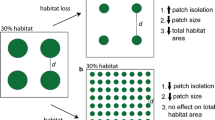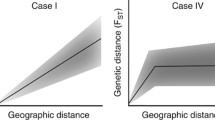Abstract
Population connectivity is mediated by the movement of organisms or propagules through landscapes. However, little is known about how variation in the pattern of landscape mosaics affects the detectability of landscape genetic relationships. The goal of this paper is to explore the impacts of limiting factors on landscape genetic processes using simulation modeling. We used spatially explicit, individual-based simulation modeling to quantify the effects of habitat area, fragmentation and the contrast in resistance between habitat and non-habitat on the apparent strength and statistical detectability of landscape genetic relationships. We found that landscape genetic effects are often not detectable when habitat is highly connected. In such situations landscape structure does not limit gene flow. We also found that contrast in resistance values between habitat and non-habitat interacts with habitat extensiveness and fragmentation to affect detectability of landscape genetic relationships. Thus, the influence of landscape features critical to providing connectivity may not be detectable if gene flow is not limited by spatial patterns or resistance contrast of these features. We developed regression equations that reliably predict whether or not isolation by resistance will be detected independently of isolation by distance as a function of habitat fragmentation and contrast in resistance between habitat and non-habitat.


Similar content being viewed by others
References
Balkenhol N, Gugerli F, Cushman SA, Waits LP, Coulon A, Arntzen JW, Holderegger R, Wagner HH et al (2009) Identifying future research needs in landscape genetics: Where to from here? Landsc Ecol 24:455–463
Balloux F (2001) EASYPOP (Version 1.7): a computer program for population genetics simulations. J Hered 92:301–302
Bowcock AM, Ruiz-Linares A, Tomfohrde J, Minch E, Kidd JR, Cavalli-Sforza LL (1994) High resolution of human evolutionary trees with polymorphic micorsatellites. Nature 368:455–457
Broquet T, Johnson CA, Petit E, Thompson I, Burel F, Fryxell JM (2006) Dispersal and genetic structure in the American marten, Martes americana. Mol Ecol 15:1689–1697
Brown JH, Kodric-Brown A (1977) Turnover rates in insular biogeography: effect of immigration on extinction. Ecology 58:445–449
Bruggeman DJ, Wiegand T, Fernandez N (2010) The relative effects of habitat loss and fragmentation on population genetic structure. Mol Ecol 19:3679–3691
Burnham KP, Anderson DR (2002) Model selection and multimodel inference: a practical information-theoretic approach. Springer, New York
Castellano S, Balletto E (2002) Is the partial mantel test inadequate? Evolution 56:1871–1873
Cushman SA (2006) Effects of habitat loss and fragmentation on amphibians: a review and prospectus. Biol Conserv 128:231–240
Cushman SA, Landguth EL (2010) Spurious correlations and inference in landscape genetics. Mol Ecol 19:3592–3602
Cushman SA, Lewis J (2010) Movement behavior explains genetic differentiation in American black bear. Landsc Ecol 25:1613–1625
Cushman SA, McKelvey KS, Hayden J, Schwartz MK (2006) Gene-flow in complex landscapes: testing multiple models with causal modeling. Am Nat 168:486–499
Cushman SA, McGarigal K, Neel M (2008) Parsimony in landscape metrics: strength, universality, and consistency. Ecol Ind 8:691–703
Cushman SA, Compton BW, McGarigal K (2010) Habitat fragmentation effects depend on complex interactions between population size and dispersal ability: modeling influences of roads, agriculture and residential development across a range of life-history characteristics. In: Cushman SA, Huettman F (eds) Spatial complexity, informatics and wildlife conservation. Springer, Tokyo, pp 369–387
Cushman SA, Raphael MG, Ruggiero LF, Shirk AS, Wasserman TN, O’Doherty EC (2011) Limiting factors and landscape connectivity: American marten in the Rocky Mountains. Landsc Ecol 26:1137–1149
Cushman SA, Landguth EL, Shirk AJ (2012) Separating the effects of habitat area, fragmentation and matrix resistance on genetic differentiation in complex landscapes. Landsc Ecol 27:369–380
Epperson BK, McRae B, Scribner K, Cushman SA, Rosenberg MS, Fortin M-J, James PMA, Murphy M, Manel S, Legendre P, Dale MRT (2010) Utility of computer simulations in landscape genetics. Mol Ecol 19:3540–3564
ESRI (1999–2008) Environmental System Research Institute, Redlands
Fahrig L (2003) Effects of habitat fragmentation on biodiversity. Ann Rev Ecol Syst 34:487–515
Fahrig L, Merriam G (1985) Habitat patch connectivity and population survival. Ecology 66:1762–1768
Fahrig L, Paloheimo J (1988) Effect of spatial arrangement of habitat patches on local population size. Ecology 69:468–475
Fahrig L, Pedlar JH, Pope SE, Taylor PD, Wegner JF (1995) Effect of road traffic on amphibian density. Biol Conserv 73:177–182
Flather CH, Bevers M (2002) Patchy reaction-diffusion and population abundance: the relative importance of habitat amount and arrangement. Am Nat 159:40–56
Gardner RH (1999) RULE: a program for the generation of random maps and the analysis of spatial patterns. In: Klopatek JM, Gardner RH (eds) Landscape ecological analysis: issues and applications. Springer, New York, pp 280–303
Gardner RH, O’Neill RV (1991) Pattern, process and predictability: the use of neutral models for landscape analysis. In: Turner MG, Gardner RH (eds) Quantitative methods in landscape ecology. Springer, New York, pp 289–308
Gardner RH, Milne BT, Turner MG, O’Neill RV (1987) Neutral models for the analysis of broad scale landscape pattern. Landsc Ecol 1(19):28
Gardner RH, O’Neill RV, Turner MG, Dale VH (1989) Quantifiying scale-dependent effects of animal movement with simple percolation models. Landsc Ecol 3:217–227
Gibbs JP (1998) Amphibian movements in response to forest edges, roads, and streambeds in southern New England. J Wildl Manag 62:584–589
Goslee SC, Urban DL (2007) The ecodist package for dissimilarity-based analysis of ecological data. J Stat Softw 22:1–19
Hanski I (2005) The shrinking world: ecological consequences of habitat loss. Excellence in ecology book 14. International Ecology Institute, Oldendorf/Luhe
Hanski I, Ovaskainen O (2000) The metapopulation capacity of a fragmented landscape. Nature 404:755–758
Harrell FE Jr (2001) Regression modelling strategies: with applications to linear models. Regression Analyses and Survival Models. Springer, New York
Harrison S (1991) Local extinction in a metapopulation context: an empirical evaluation. Biol J Linn Soc 42:73–88
Holderegger R, Wagner HH (2008) Landscape genetics. Bioscience 58:199–207
Hosmer DW, Lemeshow S (1989) Applied logistic regression. Wiley, New York
Jaquiéry J, Broquet T, Hirzel AH, Yearsley J, Perrin N (2011) Inferring landscape effects on dispersal from genetic distances: How far can we go? Mol Ecol 20:692–705
Koen EL, Bowman J, Mills SC, Wilson PJ (2012) Landscape resistance and American marten gene flow. Landsc Ecol 27:29–43
Kyle CJ, Strobeck C (2003) Genetic homogeneity of Canadian mainland marten populations underscores the distinctiveness of Newfoundland pin martens (Martes americana atrata). Can J Zool 81:57–66
Kyle CJ, Davis CS, Strobeck C (2000) Microsatellite analysis of North American pine marten (Martes americana) populations from the Yukon and northwest territories. Can J Zool 78:1150–1157
Landguth EL, Cushman SA (2010) CDPOP: an individual-based, cost-distance spatial population genetics model. Mol Ecol Resour 10:156–161
Landguth EL, Cushman SA, Luikart G, Murphy MA, Schwartz MK, McKelvey KS (2010) Quantifying the lag time to detect barriers in landscape genetics. Mol Ecol 19:4179–4191
Lee-Yaw JA, Davidson A, McRae BH, Green DM (2009) Do landscape processes predict phylogeographic patterns in the wood frog? Mol Ecol 18:1863–1874
Legendre P (1993) Spatial autocorrelation: Trouble or new paradigm? Ecology 74:1659–1673
Legendre P, Fortin M-J (2010) Comparison of the mantel test and alternative approaches for detecting complex multivariate relationships in the spatial analysis of genetic data. Mol Ecol Resour 10:831–844
Legendre P, Troussellier M (1988) Aquatic heterotrophic bacteria: modeling in the presence of spatial autocorrelation. Limnol Oceanogr 33:1055–1067
Lindenmayer DB, Fischer J (2007) Tackling the habitat fragmentation pancheton. Trends Ecol Evol 22:111–166
Manel S, Schwartz MK, Luikart G, Taberlet P (2003) Landscape genetics: combining landscape ecology and population genetics. Trends Ecol Evol 18:189–197
Manel S, Berthoud F, Bellemain E et al (2007) A new individual-based spatial approach for identifying genetic discontinuities in natural populations. Mol Ecol Resour 16:2031–2043
Mantel N (1967) The detection of disease clustering and a generalized regression approach. Cancer Res 27:209–220
McGarigal K, Cushman SA, Neel MC, Ene E (2002) FRAGSTATS: Spatial pattern analysis program for categorical maps. Computer software program produced by the authors at the University of Massachusetts, Amherst
McRae BH, Beier P (2007) Circuit theory predicts gene flow in plant and animal populations. Proc Natl Acad Sci USA 104:19885–19890
Murphy MA, Evans JS, Storfer A (2010) Quantifying bufo boreas connectivity in Yellowstone National Park with landscape genetics. Ecology 91:252–261
Neel MC, Cushman SA, McGarigal K (2004) Behavior and stability of landscape metrics across controlled gradients of landscape structure. Landsc Ecol 19:435–455
Pearson SM, Gardner RH (1997) Neutral models: useful tools for understanding landscape pattern. In: Bissonette JA (ed) Wildlife and landscape ecology. Springer, New York, pp 215–230
Pérez-Espona S, Pérez-Barbería FJ, McLeod JE, Jiggins CD, Gordon IJ, Pemberton JM (2008) Landscape features affect gene flow of Scottish Highland red deer (Cervus elaphus). Mol Ecol 17:981–996
Raufaste N, Rousset F (2001) Are partial mantel tests adequate? Evolution 55:1703–1705
Reh W, Seitz A (1990) The influence of land use on the genetic structure of populations of the common frog Rana temporaria. Biol Conserv 54:239–249
Revilla E, Wiegand T (2008) Individual movement behavior, matrix heterogeneity, and the dynamics of spatially structured populations. Proc Natl Acad Sci USA 105:19120–19125
Schumaker NH (1996) Using landscape indices to predict habitat connectivity. Ecology 77:1210–1225
Segelbacher G, Cushman SA, Epperson BK, Fortin M-J, Francois O, Hardy OJ, Holderegger R, Manel S (2010) Applications of landscape genetics in conservation biology: concepts and challenges. Conserv Genet 11:375–385
Shirk, AJ, Cushman SA, Landguth EL (2012) Simulating pattern-process relationships to validate landscape genetic models. Int J Ecol 2012:8 (Article ID 539109)
Shirk A, Wallin DO, Cushman SA, Rice RC, Warheit C (2010) Inferring landscape effects on gene flow: a new multi-scale model selection framework. Mol Ecol 19: 3603–1619
Short Bull RA, Cushman SA, Mace R, Chilton T, Kendall KC. Landguth EL, Schwartz MK, McKelvey KS, Allendorf FW, Luikart G (2011) Why replication is important in landscape genetics: American black bear in the Rocky Mountains. Mol Ecol 20:1092–1107
Small MP, Stone KD, Cook JA (2003) American marten (Martes americana) in the Pacific Northwest: population differentiation across a landscape fragmented in time and space. Mol Ecol 12:89–103
Spear SF, Storfer A (2008) Landscape genetic structure of coastal tailed frogs (Aschaphus truei) in protected vs. managed forests. Mol Ecol 17:4642–4656
Spear SF, Peterson CR, Matocq MD, Storfer A (2005) Landscape genetics of the blotched tiger salamander (Ambystoma tigrinum melanostictum). Mol Ecol 14:2553–2564
R Development Core Team (2009) R: a language and environment for statistical computing. r foundation for statistical computing, Vienna. http://www.R-project.org. ISBN 3-900051-07-0
Wasserman TN, Cushman SA, Schwartz MK, Wallin DO (2010) Spatial scaling and multi-model inference in landscape genetics: Martes americana in northern Idaho. Landsc Ecol 25:1601–1612
Wasserman TN, Cushman SA, Shirk AS, Landguth EL, Littell JS (2012a) Simulating the effects of climate change on population connectivity of American marten (Mates americana) in the northern Rocky Mountains, USA. Landsc Ecol 26:211–225
Wasserman TN, Cushman SA, Littell JS, Shirk AJ, Landguth EL (2012b) Population connectivity and genetic diversity of American marten (Martes americana) in the United States northern Rocky Mountains in a climate change context. Conserv Genet. doi:10.1007/s10592-012-0336-z
Wiegand T, Moloney KA, Naves J, Knauer F (1999) Finding the missing link between landscape structure and population dynamics: a spatially explicit perspective. Am Nat 154:605–627
Wiegand T, Revilla E, Moloney ME (2005) Effects of habitat loss and fragmentation on population dynamics. Conserv Biol 19:108–121
With KA (1994) Using fractal analysis to identify how species perceive landscape structure. Landsc Ecol 9:25–36
With KA (1997) The application of neutral landscape models in conservation biology. Conserv Biol 11:1069–1080
With KA, Crist TO (1995) Critical thresholds in species’ responses to landscape structure. Ecology 76:2446–2459
With KA, King AW (1999) Extinction thresholds for species in fractal landscapes. Conserv Biol 13:314–326
Author information
Authors and Affiliations
Corresponding author
Electronic supplementary material
Below is the link to the electronic supplementary material.
Rights and permissions
About this article
Cite this article
Cushman, S.A., Shirk, A.J. & Landguth, E.L. Landscape genetics and limiting factors. Conserv Genet 14, 263–274 (2013). https://doi.org/10.1007/s10592-012-0396-0
Received:
Accepted:
Published:
Issue Date:
DOI: https://doi.org/10.1007/s10592-012-0396-0




